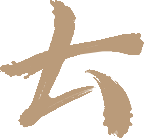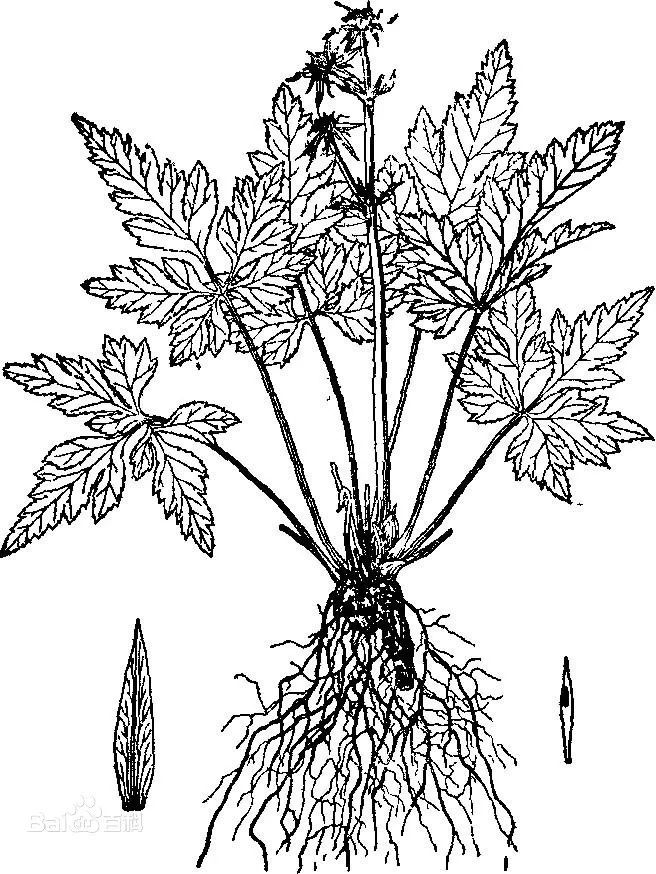




Traditional Chinese Medicine Encyclopedia
Huang Lian




·Huang Lian·
Category
Clearing Heat Medicine – Clearing Heat and Drying Dampness Medicine
Source
It is the dried rhizome of the Ranunculaceae plant Huang Lian (Coptis chinensis Franch.), Triangular-leaved Huang Lian (C. deltoidea C.Y. Cheng et Hsiao), or Yun Lian (C. teeta Wall.).
Related Names
Yun Lian, Ya Lian, Chuan Lian, Wei Lian, Ji Zhua Lian
Production Area and Growth Environment
Wei Lian is mainly produced in Sichuan and Hubei. It is also produced in Shaanxi (Pingli).
Ya Lian is mainly produced in Sichuan (Emei, Hongya).
Yun Lian is mainly produced in Yunnan (Deqin, Weixi, Tengchong, Bi Jiang).
Harvesting and Processing
It is best harvested after the beginning of winter (November). After digging, remove the stems, leaves, fibrous roots, and soil, then dry in the sun or bake, and remove the coarse skin.
Properties and Taste
Bitter, cold. Enters the Heart, Spleen, Stomach, Gallbladder, and Large Intestine meridians.
Functions
Clears heat and dries dampness, drains fire and detoxifies. Used for damp-heat fullness, vomiting with sour regurgitation, dysentery, jaundice, high fever with delirium, excessive heart fire, irritability and insomnia, blood heat with vomiting or nosebleeds, red eyes, toothache, diabetes, and carbuncles; externally used for eczema, wet sores, and ear discharge. Jiu Huang Lian (Wine Huang Lian) is good for clearing heat from the upper jiao. Used for red eyes and oral ulcers. Jiang Huang Lian (Ginger Huang Lian) clears the stomach and stops vomiting. Used for cold-heat counterflow, damp-heat obstruction, fullness, and vomiting. Yu Huang Lian (Evodia Huang Lian) soothes the liver and harmonizes the stomach to stop vomiting. Used for disharmony between the liver and stomach, vomiting with sour regurgitation.


Applications
1. Damp-heat fullness, vomiting with sour regurgitation. This herb is extremely bitter and cold, with a stronger ability to clear heat and dry dampness than Huang Qin (Scutellaria baicalensis), especially effective for clearing damp-heat from the middle jiao. It treats damp-heat stagnation in the middle jiao, causing fullness in the abdomen and nausea and vomiting, often combined with Su Ye (Perilla leaf) in Su Ye Huang Lian Tang (formula from “Wen Re Jing Wei”, noted in “Traditional Chinese Gynecology”). It can also be combined with Huang Qin, Gan Jiang (Dried Ginger), and Ban Xia (Pinellia) in Ban Xia Xie Xin Tang (“Shang Han Lun”). If combined with Shi Gao (Gypsum), it can treat stomach heat vomiting, as in Shi Lian San (“Xian Nian Ji”). If combined with Wu Zhu Yu (Evodia), it can treat liver fire invading the stomach causing rib-side distention and vomiting with sour regurgitation, as in Zuo Jin Wan (“Dan Xi Xin Fa”). If combined with Ren Shen (Ginseng), Bai Zhu (Atractylodes), and Gan Jiang, it can treat spleen and stomach deficiency-cold with sour vomiting, as in Lian Li Tang (“Zheng Yin Mai Zhi”). 2. Damp-heat dysentery. This herb is effective in removing damp-heat from the spleen, stomach, and large intestine, making it a key medicine for treating dysentery, effective when used alone. If combined with Mu Xiang (Aucklandia), it can treat damp-heat dysentery with abdominal pain and urgency, as in Xiang Lian Wan (“Bing Bu Shou Ji Fang”). If combined with Ge Gen (Pueraria) and Huang Qin, it can treat damp-heat dysentery with exterior symptoms and fever, as in Ge Gen Huang Qin Huang Lian Tang (“Shang Han Lun”). If combined with Wu Mei (Mume), it can treat chronic damp-heat dysentery with pus and blood, as in Huang Lian Wan (“Wai Tai Mi Yao”). 3. High fever with delirium, irritability and insomnia, blood heat with vomiting or nosebleeds. This herb is particularly good at draining fire and detoxifying, especially effective for clearing excess heart fire, and can be used to treat delirium and irritability caused by excessive heart fire. If combined with Huang Qin, Huang Bai (Phellodendron), and Zhi Zi (Gardenia), it can treat excessive heat in the three jiao, high fever, and irritability; if combined with Shi Gao, Zhi Mu (Anemarrhena), Xuan Shen (Scrophularia), and Dan Pi (Moutan), it can treat high fever with delirium, as in Qing Wen Bai Du Yin (“Yi Zhen Yi De”); if combined with Huang Qin, Bai Shao (White Peony), and E Jiao (Donkey-hide Gelatin), it can treat heat damaging yin, irritability, and insomnia, as in Huang Lian E Jiao Tang (“Shang Han Lun”); if combined with Rou Gui (Cinnamon), it can treat excessive heart fire and insomnia due to disharmony between heart and kidney, as in Jiao Tai Wan (“Si Ke Jian Xiao Fang”); if combined with Da Huang (Rhubarb) and Huang Qin, it can treat internal heat fire causing blood to recklessly flow, resulting in vomiting or nosebleeds, as in Xie Xin Tang (“Jin Kui Yao Lue”). 4. Carbuncles, boils, and red eyes with toothache. This herb can both clear heat and dry dampness, as well as drain fire and detoxify, especially effective for treating carbuncles and boils. It is used for carbuncles and boils, often combined with Huang Qin, Huang Bai, and Zhi Zi, as in Huang Lian Jie Du Tang (“Wai Tai Mi Yao”); if combined with Dan Zhu Ye (Lophatherum), it can treat red, swollen, and painful eyes, as in Huang Lian Tang (“Pu Ji Fang”); if combined with Sheng Di Huang (Rehmannia), Sheng Ma (Cimicifuga), and Dan Pi, it can treat stomach fire attacking upward, causing unbearable toothache, as in Qing Wei San (“Lan Shi Mi Cang”). 5. Diabetes. This herb is good at clearing stomach fire and can be used to treat diabetes due to excessive stomach fire, often combined with Mai Dong (Ophiopogon) in treating diabetes pills (“Pu Ji Fang”); or combined with Huang Bai to enhance its fire-draining ability, as in Huang Bai Wan (“Sheng Ji Zong Lu”); if combined with Sheng Di Huang, it can treat kidney yin deficiency and excessive heart and stomach fire causing diabetes, as in Huang Lian Wan (“Wai Tai Mi Yao”). 6. External treatment for eczema, wet sores, and ear discharge. This herb has the ability to clear heat and dry dampness, drain fire and detoxify, and can be made into an ointment for external application to treat skin eczema and wet sores. The juice can be applied to the affected area to treat ear discharge; decoction can be used as eye drops to treat red and swollen eyes.
Summary from Ancient Texts
1. “Shen Nong Ben Cao Jing”: “It is used for heat causing eye pain, tears, intestinal lumps, abdominal pain, dysentery, and swelling and pain in women’s private parts.” 2. “Zhen Zhu Nang”: “Its uses are six: draining heart fire, one; removing damp-heat from the middle jiao, two; treating all sores, three; removing wind-dampness, four; treating red eyes and eruptions, five; stopping bleeding in the middle jiao, six.” 3. “Ben Cao Zheng Yi”: “Huang Lian is extremely bitter and cold, it can dry dampness and clear heat, and can drain all excess damp-heat from the heart, spleen, liver, kidney, gallbladder, stomach, and large intestine. It clears wind-fire eye diseases above, harmonizes the liver and stomach to stop vomiting in the middle, and unblocks abdominal pain below, all of which are effects of drying dampness and clearing heat. Moreover, its bitterness first enters the heart, clearing blood heat, thus it is effective for blood-related diseases such as vomiting blood, hematuria, dysuria, hemorrhoids, and carbuncles, and all are reliant on this herb.”
Usage Precautions
This herb is extremely bitter and cold; excessive or prolonged use can easily harm the spleen and stomach, and it should be avoided by those with spleen and stomach deficiency-cold; its bitterness and dryness can easily harm yin fluids, so it should be used cautiously by those with yin deficiency and fluid damage.
Physical Characteristics
Wei Lian: Often clustered, usually curved, resembling a chicken’s claw, with single branches measuring 3-6 cm in length and a diameter of 0.3-0.8 cm. The surface is grayish-yellow or yellow-brown, rough, with irregular nodular protrusions, fibrous roots, and remnants of fibrous roots. Some segments have a smooth surface like a stem, commonly referred to as “crossing the bridge”. The upper part often retains brown scales, and the tip usually has remnants of stems or leaf stalks. It is hard, with an uneven cross-section, the skin part is orange-red or dark brown, and the wood part is bright yellow or orange-yellow, arranged radially, with some hollow pith. It has a faint odor and is extremely bitter.
Ya Lian: Mostly single branches, slightly cylindrical, slightly curved, measuring 4-8 cm in length and 0.5-1 cm in diameter. The “crossing the bridge” part is longer.
Yun Lian: Curved and hook-shaped, mostly single branches, smaller in size.
Identification of Quality
Huang Lian products can be roughly divided into the following types based on the original plant and production area:
1. Wei Lian, also known as Chuan Lian (“Ben Cao Meng Quan”), Ji Zhua Lian, Ji Zhua Huang Lian, Guang Lian. It is the dried rhizome of the Huang Lian plant, often branched, usually 3-6 branches bundled together, slightly curved, resembling a chicken’s claw, about 3-7 cm long, with a single branch diameter of 3-8 mm. The outer surface is yellow-brown, and the cork layer is red-brown where it has fallen off; the branches have intermittent transverse stripes, and the nodules are enlarged, resembling beads, with many hard fine fibrous roots and root marks. Some surfaces are smooth without transverse stripes, commonly referred to as “crossing the river branch” or “crossing the bridge rod”; the upper part often has brown scale remnants, and the tip has unremoved remnants of stems or leaf stalks. It is solid and hard, with an uneven cross-section, the skin part is dark brown, the wood part is golden yellow, with rays having fissures, and the central pith is reddish-yellow, occasionally hollow. It has no odor and is extremely bitter, and chewing it can stain saliva red-yellow. The best quality is characterized by thick, bead-like, solid texture, with a red-yellow cross-section and no remnants of stems or fibrous roots.
All belong to cultivated products, mainly produced in Sichuan and Hubei. It is also produced in Shaanxi (Pingli).
2. Ya Lian (“Ben Cao Cong Xin”), also known as Emei Lian, Jiading Lian, Ci Gai Lian. It is the dried rhizome of the Triangular-leaved Huang Lian plant. Mostly single branches, rarely branched, slightly cylindrical, slightly curved like a silkworm, measuring about 4-8 cm in length and 3-9 mm in diameter. The outer surface is brown or yellow-brown, with many intermittent transverse stripes and obvious nodules, with many fibrous root remnants, leaf stalk remnants, and scales, and the “crossing the bridge” part is less than Wei Lian. It is solid, with an uneven cross-section, the skin part is dark brown, the wood part is deep yellow, with rays being obvious, and the pith is sometimes hollow. It has no odor and is extremely bitter. The best quality is characterized by thick, bead-like, solid texture, with a yellow cross-section and no remnants of stems or fibrous roots.
All belong to cultivated products, mainly produced in Sichuan (Emei, Hongya).
3. Yun Lian (“Ben Cao Cong Xin”) is mainly the dried rhizome of the Yunnan Huang Lian plant. It is smaller, often curved, and mostly single branches, shaped like a scorpion’s tail, measuring about 1.5-8 cm in length and 2-4 mm in diameter. The outer skin is yellow-green or gray-yellow. The other characteristics are roughly the same as the above varieties.
It can be cultivated or wild. Mainly produced in Yunnan (Deqin, Weixi, Tengchong, Bi Jiang).
In addition, there are also Short-Calyx Huang Lian (distributed in Guangxi, Guangdong, Fujian, Anhui, Zhejiang, Jiangxi, Hunan, Guizhou, with little cultivation) and Five-Lobed Huang Lian (distributed in southeastern Yunnan), which are also used medicinally.
The roots of the Short-Calyx Huang Lian plant are commonly referred to as “Tu Huang Lian” or “Tu Chuan Lian”, with small-scale production in various regions; the roots of the Five-Lobed Huang Lian are also used as “Yun Lian” in Yunnan. The remaining parts of the Huang Lian processing process – Huang Lian Xu (fibrous roots), Jian Kou Lian (leaf stalk base), Qian Zi Lian (all leaf stalks), Huang Lian Ye (leaves), Huang Lian Zha (residue from the pounding process) are also used in a few regions instead of Huang Lian.
Processing
Huang Lian: Remove impurities, soak until soft, cut into thin slices, dry, or crush when needed.
Jiu Huang Lian: Take clean Huang Lian, and roast it dry using wine. For every 100 kg of Huang Lian, use 12.5 kg of yellow wine.
Jiang Huang Lian: Take clean Huang Lian, and roast it dry using ginger juice. For every 100 kg of Huang Lian, use 12.5 kg of fresh ginger.
Yu Huang Lian: Take Wu Zhu Yu and boil it with an appropriate amount of water, mix the decoction with clean Huang Lian, and dry after the liquid is absorbed. For every 100 kg of Huang Lian, use 10 kg of Wu Zhu Yu.
Jiu Huang Lian, Jiang Huang Lian, and Yu Huang Lian should not exceed 4.0% total ash content as determined by the above methods.
Identification of Medicinal Use
This herb can be used raw, and there are also special processed products such as Jiu (wine) Huang Lian, Jiang (ginger) Huang Lian, and Wu Zhu Yu water Huang Lian, each with different functions. Jiu Huang Lian is good for clearing heat from the upper jiao, often used for red, swollen, and painful eyes and oral ulcers; Jiang Huang Lian is good for clearing the stomach and stopping vomiting, often used for cold-heat counterflow, damp-heat obstruction, fullness, and vomiting; Yu Huang Lian is good for soothing the liver and harmonizing the stomach to stop vomiting, often used for disharmony between the liver and stomach causing vomiting with sour regurgitation.
Specifications of Traditional Chinese Medicine
Wei Lian First Grade: Often clustered, with thick and solid branches, with some crossing the bridge, not exceeding 2 cm in length. No fragments less than 1.5 cm, no remnants of stems, no burnt or moldy impurities. Second Grade: Thinner than first grade, with some crossing the bridge. May have fragments, burnt, or moldy parts.
Ya Lian First Grade: Single branches, few crossing the bridge, not exceeding 2.5 cm in length. No fragments, no fine hairs, no burnt or moldy impurities. Second Grade: Thinner than first grade, with more crossing the bridge. May have fragments, fine hairs, burnt parts.
Yun Lian First Grade: Single branches, diameter over 0.3 cm. No fine hairs, no crossing the bridge, no impurities, no mold. Second Grade: Thinner, diameter under 0.3 cm, may have crossing the bridge.
Remarks
Combined with Huang Qin, Da Huang, etc., it can treat symptoms of damp-heat accumulation. For damp-heat lingering in the stomach and intestines, it is often combined with Ban Xia and Zhu Ru to stop vomiting, and with Mu Xiang, Huang Qin, and Ge Gen to treat dysentery. For febrile diseases with high fever and excessive heart fire, it has good therapeutic effects, often combined with Shan Zhi (Gardenia) and Lian Qiao (Forsythia); for blood heat recklessly flowing, it can be combined with Huang Qin and Da Huang; for heat toxin sores and ulcers, it can be combined with Chi Shao (Red Peony) and Dan Pi. For stomach fire blazing in the middle, it can be combined with Tian Hua Fen (Trichosanthes) and Zhi Mu, Sheng Di Huang. Externally, Huang Lian juice can be used as eye drops to treat excessive fire causing red eyes; applied to the mouth to treat oral ulcers.

Zhangpu County Traditional Chinese Medicine Hospital
Virtue, Precision, Inheriting the Old, Embracing the New
WeChat Official Account ID: zzszpxzyy

